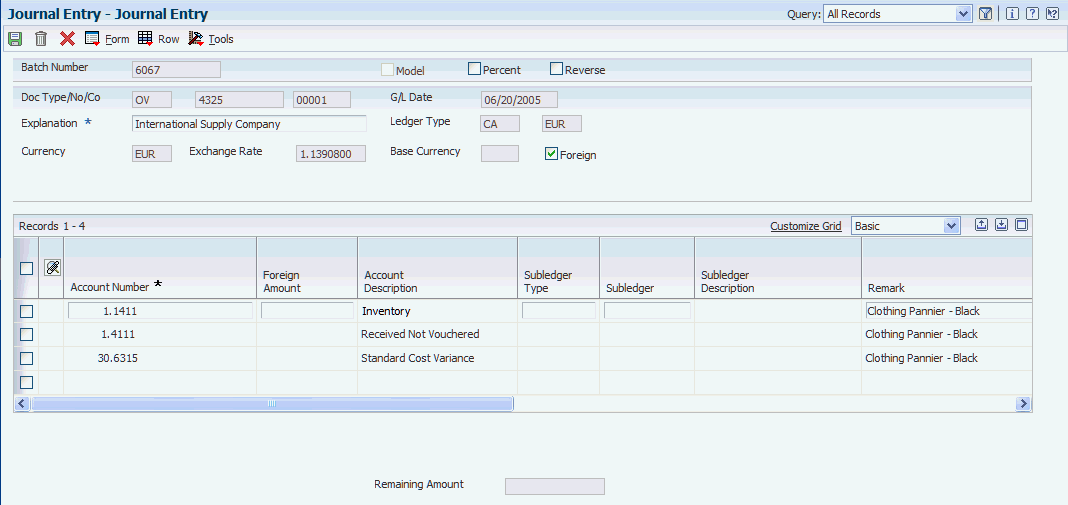Table of Content
Home currency adjustments are normally recorded to prepare financial statements, so that balances held in foreign currencies can be converted to the exchange rate as of the financial statement date. If foreign balances were not adjusted to current exchange rates, the balances reported on the balance sheet could materially mis-state a firm’s financial position. The home currency adjustment records an exchange gain or loss to reflect the change in the value of a firm’s balance sheet accounts. This has been the case for many years, and despite it being repeatedly reported as a bug, and despite Intuit releasing a shiny new version of Quickbooks every single year, it has never been fixed.
Next, debit 990 to the Exchange Gain/Loss Unrealised account and save the journal. A home currency adjustment journal is a journal to adjust the home currency value; therefore, the foreign currency balance of the foreign currency bank account remains unchanged. Pass a home currency adjustment journal to debit SGD0.02 to the foreign currency bank and credit SGD0.02 from the home currency bank.
Manually Adjust Home Currency
Financial statement reports such as a P & L or balance sheet are always in your home currency. Some reports show foreign balances, while other reports provide the option of showing both home currency and foreign balances. The Exchange Gain or Loss account automatically created by QuickBooks records both realized and unrealized gains/losses. QuickBooks accounting software has multiple characteristics which makes the life easy for the user.
To account for this, at the end of the fiscal year, you perform a “home currency adjustment”. This involves comparing the home and foreign currency balances of the account, and journaling the difference to a currency exchange gain/loss expense account. From the Home Currency Adjustment window, QuickBooks automatically posts home currency adjustments by a General Journal entry to the Exchange Gain or Loss account that is automatically created by QuickBooks as an Other Expense account type. Therefore, debits to this account will represent exchange losses and increase this expense; credits will represent exchange gains and decrease this expense. QuickBooks takes every open balance in the A/R and the A/P in Euro and revalues them as of the valuation date. The total unrealized gain or loss will show up in the row for each of these open transactions, so that you can easily see how all home currency adjustments affect each transaction.
What is Multicurrency in QuickBooks?
In order to synchronize transactions in different currencies, make sure the Multicurrency setting is enabled in QuickBooks Online. You are required to utilize the international currency accounts or names which are included for new international transactions. In invoices, online payment will stop working for multiple currencies.

The problem is, when this feature was created, someone apparently added a conditional causing it to skip any accounts with zero balance. After all, if there’s nothing in the account, no need to adjust it, right? If you consider the example above, but instead imagine depositing $100 and then withdrawing $100 at a different exchange rate, it’s clear that the foreign balance can easily be zero while there is still an account balance that needs to be adjusted. And in fact, this is a very common situation, because foreign accounts are often accounts payable or accounts receivable, where invoices are created and then paid before the end of the month, resulting in a foreign balance of zero. Due to the differences in exchange rate, the amount received in the home currency bank, which has transferred from a foreign currency bank account, could be different from the amount recorded in the QuickBooks accounting software. Beware of a quirk/bug in the home currency adjustment which causes problems with Example 1.
Related image with quickbooks desktop home currency adjustment with multi currency
From the Payee dropdown menu, you have to select the vendor that you created with your employee’s info. Aggregate deals & buy exchanges are in the supplier’s currency and the home cash proportional is recorded for the exchange complete. You do not assign cash to purchase & sales transactions since they are allocated the currency of the client or seller that have been entered by you in the form. Fixed Asset Manager and Statement Writer only utilize U.S. currency. They won’t be affected by turning on the multiple currency function.

Once it’s done, begin with the list like Customer Pays Me & select the Customer’s currency. After adding their info, you have to choose a currency from the Currency dropdown menu. Search the vendor you want to change the currency to and then select their name. Then search and select the name of the customer with that you want to change currency.
Then based on the Unrealised Exchange Gain/Loss report, record a home currency adjustment journal into QuickBooks. Since the inception of the Quickbooks multicurrency feature roughly a decade ago, it has had a very simple bug that causes home currency adjustments to be performed incorrectly. This effectively means that most people using Quickbooks in multiple currencies, if they don’t know how to work around the bug, will be filing incorrect tax returns each year. The error could be large or small, but will always be present if the common conditions I’ll describe here are present. QuickBooks Premier allows user to pass a currency adjustment journal automatically via a Home Currency Adjustment Wizard .
By the way, it’s nice to know that QBO lets me assign a foreign currency to fixed asset accounts, in addition to any balance sheet account other than equity, accounts receivable, and accounts payable accounts. From the Company menu, select Make General Journal, check the Home Currency Adjustment checkbox at the bottom of the journal and record the journal in Singapore dollar. On the first line of the journal, select foreign currency accounts receivable account, enter the loss of 990 under the credit column and select USD AR Adjustment in the name column.
Learn how to create home currency adjustments in QuickBooks Online. The above blog will help you in knowing the steps to set up and enable this feature in QuickBooks. In case, you face any challenge to understand about multi-currency in QuickBooks or required some more guidance for the same, then do not hesitate to get in touch with Dancing Numbers expert and get consultation. Later click on save option, examine the supplier list page, the supplier name and overseas currency will appear on this list.
Assuming you want to make a home currency adjustment for your foreign bank account, you need to debit/credit your foreign bank account and credit/debit the Exchange Gain/Loss Unrealised account. That will help you to easily see which rates were applied to each transaction. The first line is the realized portion of the exchange gain; the second line – the General Journal entry – is for the unrealized home currency adjustment.
Furthermore, using Dancing Numbers saves a lot of your time and money which you can otherwise invest in the growth and expansion of your business. It is free from any human errors, works automatically, and has a brilliant user-friendly interface and a lot more. To use the service, you have to open both the software QuickBooks and Dancing Numbers on your system. To import the data, you have to update the Dancing Numbers file and then map the fields and import it. For additional information, seetroubleshooting home currency adjustments. With the help of the above article, you can clear your doubts regarding QuickBooks Multi-Currency.

Home currency conversions can also be seen as a realized gain or loss in other account types, such as bank accounts. Until you recalculate the home currency value of your foreign balances using current exchange rates, your reports show the home currency value based on the exchange rates you used at the time of each transaction. In other words, if you have A/R in a foreign currency as of an interim date, that unpaid A/R can trigger an unrealized gain/loss. My US company, which has a calendar year-end, sells widgets to a Freedonian customer for F100,000, worth $100,000 USD on Dec. 1, 2021. On top of that, my company buys a building in Freedonia City, the capital, for F5,000,000, worth $5,000,000 USD on Dec. 15, 2021.

No comments:
Post a Comment